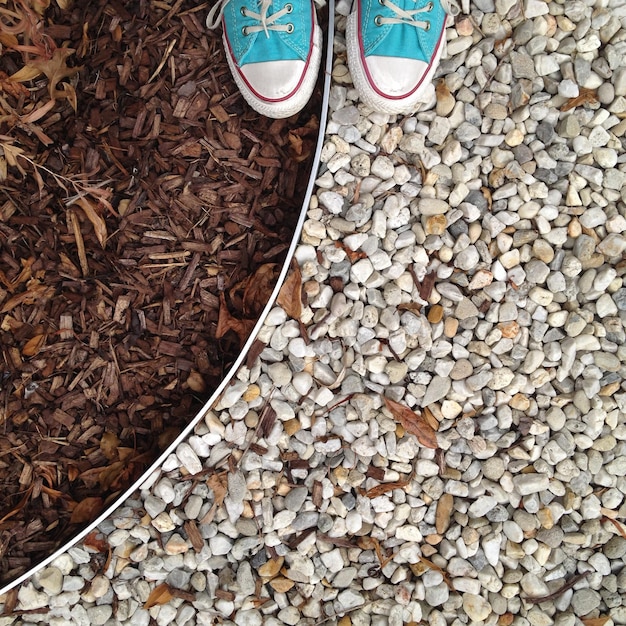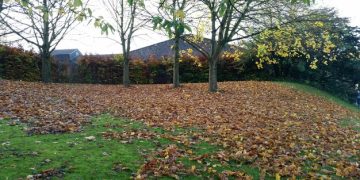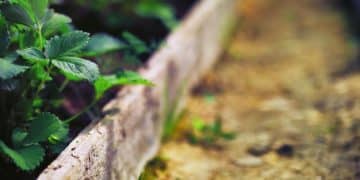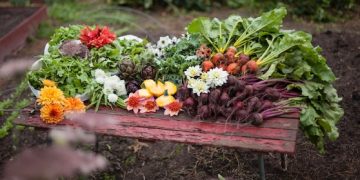Choose the Right Mulch: Organic vs. Inorganic Options

Choosing the right mulch, whether organic like wood chips or inorganic such as rocks, is crucial for plant health, soil temperature regulation, and moisture retention in your garden.
Selecting the right mulch can significantly impact your garden’s health and appearance. From controlling weeds to retaining moisture, the benefits of mulch are numerous. This article dives into choose the right mulch: a comparison of organic and inorganic mulch options, helping you make the best choice for your specific gardening needs.
Understanding the Basics of Mulch
Mulch is more than just a decorative touch in your garden; it’s a functional layer that provides numerous benefits. Understanding what mulch does and the different types available is the first step in making an informed decision.
What is Mulch and Why Use It?
Mulch is a layer of material spread on the surface of the soil. It helps to retain moisture, suppress weeds, regulate soil temperature, and even add nutrients as it decomposes. Using mulch can lead to healthier plants and a more attractive garden.
Organic vs. Inorganic Mulch: A Quick Overview
The main distinction lies in the composition and how they break down over time. Organic mulches decompose, enriching the soil, while inorganic mulches remain intact, providing long-lasting benefits without adding nutrients.

In summary, mulch is essential for maintaining healthy soil and plants. By understanding the difference between organic and inorganic options, you can choose the one that best fits your gardening needs and preferences.
Organic Mulch: Benefits and Drawbacks
Organic mulches are derived from natural sources, offering a range of benefits that extend beyond weed control and moisture retention. However, they also come with certain drawbacks that should be considered.
Advantages of Organic Mulch
- Soil Enrichment: As organic mulches decompose, they add valuable nutrients to the soil, improving its fertility and structure.
- Improved Soil Structure: Organic matter helps to aerate the soil, allowing for better water infiltration and root growth.
- Attracts Beneficial Organisms: Decomposing organic matter provides a habitat for beneficial microbes and earthworms, which further enhance soil health.
Disadvantages of Organic Mulch
- Decomposition Rate: Organic mulches break down over time, requiring replenishment to maintain their effectiveness.
- Potential Pest Harboring: Some organic materials can harbor pests or diseases if not properly composted or sourced.
- Flammability: Certain types of organic mulch, like pine straw, can be flammable, posing a fire risk in dry climates.
Organic mulch is best for gardeners looking to improve soil health and fertility. While it requires more maintenance due to decomposition, the benefits to the soil ecosystem are significant.
Inorganic Mulch: Weighing the Pros and Cons
Inorganic mulches offer a different set of advantages, primarily focused on longevity and weed control. While they don’t enrich the soil, their durability and low-maintenance nature make them a popular choice for many gardeners.
Benefits of Inorganic Mulch
- Long-Lasting: Unlike organic options, inorganic mulches don’t decompose, providing long-term weed control and moisture retention.
- Weed Control: Forms an effective barrier against weeds, blocking sunlight and preventing germination.
- Low Maintenance: Requires minimal upkeep, saving time and effort in the garden.
Potential Drawbacks of Inorganic Mulch
- No Soil Enrichment: Does not add nutrients to the soil, requiring additional fertilization for plant health.
- Heat Retention: Can absorb and retain heat, potentially harming plants in hot climates.
- Aesthetic Limitations: While available in various colors and textures, inorganic mulches may not have the natural appeal of organic options.
Inorganic mulch is a practical choice for gardeners seeking long-term weed control and low maintenance. However, it’s important to consider the potential impact on soil health and plant temperature.
Types of Organic Mulch and Their Best Uses
The world of organic mulch is diverse, each type offering unique benefits depending on your specific gardening needs. From wood chips to compost, understanding these options can help you maximize their effectiveness.

Wood Chips: A Versatile Option
Wood chips are a popular choice for pathways, shrubs, and trees. They decompose slowly, providing long-lasting weed control and moisture retention. They are best suited for areas where slow decomposition is desired and nutrient enrichment is less critical.
Straw: Ideal for Vegetable Gardens
Straw is excellent for vegetable gardens, providing insulation and preventing soil splash on plants. It decomposes relatively quickly, adding nutrients to the soil. However, it can sometimes contain weed seeds, so sourcing it from a reputable supplier is important.
Compost: The Ultimate Soil Amendment
Compost is a nutrient-rich option that improves soil structure, fertility, and water retention. It’s best used as a soil amendment rather than a top layer of mulch, as it decomposes rapidly. Mix it into the soil around plants to give them a boost.
In conclusion, each type of organic mulch has its unique uses. Consider your specific gardening goals and plant needs when choosing the best option for your landscape.
Exploring Inorganic Mulch Varieties and Applications
From gravel to rubber, inorganic mulches offer a range of options for gardeners looking for long-lasting solutions. Understanding their specific properties and best uses is essential for making the right choice.
Gravel and Rocks: Perfect for Xeriscaping
Gravel and rocks are ideal for xeriscaping, providing excellent drainage and heat retention. They are best suited for plants that thrive in dry conditions, such as succulents and cacti. However, they can be difficult to remove and don’t add any nutrients to the soil.
Rubber Mulch: A Recycled Option
Rubber mulch is made from recycled tires, offering a sustainable and long-lasting option. It’s best used in playgrounds or around trees, providing a cushion and reducing weed growth. However, it can release chemicals into the soil and may not be suitable for vegetable gardens.
Landscape Fabric: An Underlayer Solution
Landscape fabric is typically used as an underlayer beneath other mulches, preventing weed growth and retaining moisture. It’s best used in combination with organic or inorganic mulches to maximize its effectiveness. However, it can sometimes hinder water infiltration and nutrient exchange in the soil.
In summary, inorganic mulches offer long-lasting weed control and low maintenance. Consider the environmental impact and potential effects on soil health when choosing the best option for your garden.
Making the Right Choice: Matching Mulch to Your Plants and Soil
The best mulch choice depends on your specific plants, soil conditions, and gardening goals. Consider the following factors to make an informed decision that will benefit your garden:
Assessing Your Soil Type
Understanding your soil type is crucial for choosing the right mulch. For clay soils, organic mulches like compost can improve drainage and aeration. For sandy soils, mulches that retain moisture, such as peat moss, are ideal.
Considering Your Plants’ Needs
Different plants have different mulch preferences. Acid-loving plants like azaleas and rhododendrons benefit from acidic mulches like pine needles. Vegetable gardens thrive with nutrient-rich mulches like straw or compost.
Budget and Maintenance
Budget and maintenance are important considerations. Inorganic mulches are generally more expensive upfront but require less maintenance over time. Organic mulches are more affordable but need to be replenished regularly.
Ultimately, the best mulch choice is the one that meets the specific needs of your plants, soil, and gardening style. By considering these factors, you can create a thriving and beautiful garden.
| Key Point | Brief Description |
|---|---|
| 🌱 Organic Mulch | Decomposes, enriching the soil with nutrients over time. |
| 🪨 Inorganic Mulch | Lasts longer, providing weed control without adding nutrients. |
| 🌳 Wood Chips | Ideal for pathways and shrubs, decomposes slowly. |
| ♻️ Rubber Mulch | Made from recycled tires, good for playgrounds, but may release chemicals. |
Frequently Asked Questions
▼
Both organic and inorganic mulches can effectively control weeds. However, inorganic options like landscape fabric and gravel tend to offer longer-lasting weed suppression by physically blocking weed growth.
▼
Organic mulch should be replaced as it decomposes, typically every six months to a year. The rate of decomposition depends on the type of mulch and environmental conditions, such as moisture and temperature.
▼
While possible, it is not recommended. Inorganic mulches don’t add nutrients and some, like rubber, can leach chemicals. Organic mulches are preferable for vegetable gardens due to their soil-enriching properties.
▼
Some organic mulches, such as pine straw and shredded wood, can be flammable when dry. Maintain moisture to reduce fire risk and avoid placing these mulches near ignition sources.
▼
Organic mulches can sometimes attract pests, especially if they are not properly composted. Choosing appropriate materials and maintaining good garden hygiene can help minimize pest issues.
Conclusion
Ultimately, the decision to choose between organic and inorganic mulch depends on your specific gardening needs and priorities. Consider the benefits and drawbacks of each type, and choose the option that best suits your plants, soil, and lifestyle. With the right mulch, you can create a healthy and beautiful garden that thrives for years to come.





